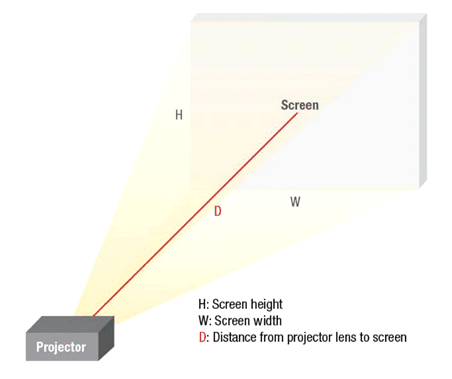DLPA068C November 2019 – May 2022 DLP160AP , DLP160CP , DLP2000 , DLP2010 , DLP230NP , DLP3010 , DLP3310 , DLP470NE , DLP470TE , DLP4710 , DLP471NE , DLP471TE , DLP471TP , DLP480RE , DLP550HE , DLP550JE , DLP650LE , DLP650NE , DLP650TE , DLP651NE , DLP660TE , DLP670RE , DLP780NE , DLP780TE , DLP781NE , DLP781TE , DLP800RE , DLP801RE , DLP801XE , DLPA1000 , DLPA2000 , DLPA2005 , DLPA3000 , DLPA3005 , DLPC2607 , DLPC3420 , DLPC3421 , DLPC3430 , DLPC3433 , DLPC3435 , DLPC3438 , DLPC3439 , DLPC4422 , DLPC6401
6 Other Considerations
While brightness, power consumption, and size are typically the most dominant system requirements, there are two additional performance parameters that product developers should consider when designing a DLP projection system: optical engine contrast ratio and projection lens throw ratio.
The contrast ratio of a projection engine impacts the perceived quality of the projected image. The higher the contrast ratio, the greater the difference between the light and dark areas of the image (see Figure 6-1). High contrast results in deep blacks and vivid looking colors.
There are two methods of measuring a systems contrast ratio: Full-On and Full-Off (FOFO) Contrast and ANSI Contrast. FOFO Contrast is essentially a measurement of the display panels inherent contrast ratio, whereas ANSI Contrast is essentially a measurement of the projection optics contrast ratio. DLP technology can enable contrast ratios of over 2,000:1, depending on the projection optics design.
 Figure 6-1 Simulated Images of High
Contrast (Above) and Low Contrast (Below)
Figure 6-1 Simulated Images of High
Contrast (Above) and Low Contrast (Below)Projection lens throw ratio relates the size of the projection image to the distance from the projection system to the projection surface, and is defined as D/W, where D is the distance from the projection lens to the projection surface, and W is the width of the projected image. This is illustrated in Figure 6-2.
While throw ratio does not impact projector brightness (lumens), it does impact image brightness (nits) from a given projection distance. Two projectors of the same projector brightness (lumens) but with different throw ratios will create different size images when placed the same distance from the viewing surface. Since the different throw ratios result in different image sizes, the image brightness levels (nits) will also be different. The projector with the shorter throw ratio will create a bigger image, and thus a dimmer image because the light (lumens) is be spread out over a larger area. Conversely, the projector with the longer throw ratio will create a smaller (and therefore brighter) image. Throw ratio should be considered based on the use case of the final product, whether the projection system will be close to the image or far away from it.
 Figure 6-2 Projection Throw Ratio
Figure 6-2 Projection Throw Ratio